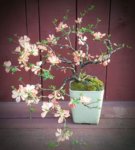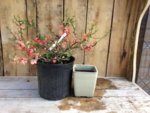shinmai
Chumono
I have six or seven Japanese quince, all acquired in June from the clearance pallet at a Home Depot. All are a cultivar named ‘Texas Scarlet’. All are doing well after repotting and substantial size reduction.
One little rascal—the one of the bunch with zero hope of ever being a bonsai—has been blooming intermittently since September. My question has to do with blossom color.
When this one bloomed the first time in September it was almost a stretch to call them red—hardly the vivid shade one sees in a Monrovia ad, for example. Subsequent blossoms have been budding as solid white, and opening to a pale salmon color.
My question is this: is there a nutritional or mineral element that affects the intensity of blossom color? Just as an example, I’m mindful of how one can turn hydrangeas pink or blue depending on the pH of the soil.
One little rascal—the one of the bunch with zero hope of ever being a bonsai—has been blooming intermittently since September. My question has to do with blossom color.
When this one bloomed the first time in September it was almost a stretch to call them red—hardly the vivid shade one sees in a Monrovia ad, for example. Subsequent blossoms have been budding as solid white, and opening to a pale salmon color.
My question is this: is there a nutritional or mineral element that affects the intensity of blossom color? Just as an example, I’m mindful of how one can turn hydrangeas pink or blue depending on the pH of the soil.



